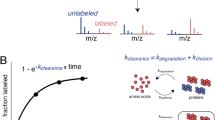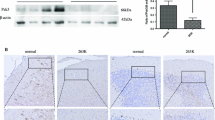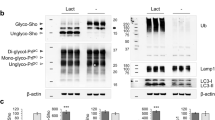Abstract
Transmissible spongiform encephalopathies (TSEs), also called prion diseases, are characterized by formation of the disease-associated isoform of prion protein (PrPSc), which arises from a normal isoform termed PrPc by a post-translational conversion process occurring in an autocatalytic fashion. Oxidative stress has been proposed as a pathogenetic mechanism in TSEs and increased lipid peroxidation has recently been described in prion-infected cell cultures, suggesting an intrinsic link between the presence of prions and oxidative stress. We investigated if poly(ADP-ribose) formation can be detected in cultured cells upon prion infection, as this NAD+-consuming and DNA strand break-activated nuclear enzymatic reaction has the potential to cause rapid and lethal NAD+ depletion in cells under severe oxidative stress. Poly(ADP-ribose) production was analysed by immunofluorescence in freshly scrapie-infected Neuro2a–D11 mouse neuroblastoma cells, which had been confirmed by immunocytochemistry to produce PrPSc, and in uninfected controls. No spontaneous poly(ADP-ribose) specific signals were observed in infected or in uninfected cells, while both cell types readily reacted to H2O2 treatment with poly(ADP-ribose) synthesis in a dose-dependent manner, with no obvious difference in staining intensity at any dose tested. In summary, our data reveal that replication of scrapie agent in neuroblastoma cells can proceed without detectable stimulation of the cellular poly(ADP-ribosyl)ation system.
Similar content being viewed by others
References
Affar EB, Duriez PJ, Shah RG, Winstall E, Germain M, Boucher C, Bourassa S, Kirkland JB, Poirier GG (1999) Immunological determination and size characterization of poly(ADP-ribose) synthesized in vitro and in vivo. Biochim Biophys Acta 1428: 137–146.
Aguzzi A, Montrasio F, Kaeser PS (2001) Prions: Health scare and biological challenge. Nat Rev Mol Cell Biol 2: 118–126.
Bosque PJ, Prusiner SB (2000) Cultured cell sublines highly susceptible to prion infection. J Virol 74: 4377–4386
Brown DR, Qin K, Herms JW, Madlung A, Manson J, Strome R, Fraser PE, Kruck T, von Bohlen A, Schulz-Schaeffer W, Giese A, Westaway D, Kretzschmar H (1997) The cellular prion protein binds copper in vivo. Nature 390: 684–687.
Brown DR, Schmidt B, Kretzschmar HA (1996) Role of microglia and host prion protein in neurotoxicity of a prion protein fragment. Nature 380: 345–347.
Brown DR, Wong BS, Hafiz F, Clive C, Haswell SJ, Jones IM (1999) Normal prion protein has an activity like that of superoxide dismutase. Biochem J 344: 1–5.
BÜrkle A (2001) Physiology and pathophysiology of poly(ADPribosyl) ation. BioEssays 23: 795–806.
BÜrkle A, Chen G, KÜpper JH, Grube K, Zeller WJ (1993) Increased poly(ADP-ribosyl)ation in intact cells by cisplatin treatment. Carcinogenesis 14: 559–561.
BÜrkle A, Kretzschmar HA, Brown DR (1999) Poly(ADP-ribose) immunostaining to detect apoptosis induced by a neurotoxic fragment of prion protein. Histochem J 31: 711–716.
Caughey B, Chesebro B (2001) Transmissible spongiform encephalopathies and prion protein interconversions. Adv Virus Res 56: 277–311.
Cereghetti GM, Schweiger A, Glockshuber R, Van Doorslaer S (2001) Electron paramagnetic resonance evidence for binding of Cu(2+) to the C-terminal domain of the murine prion protein. Biophys J 81: 516–525.
D'Amours D, Desnoyers S, D'Silva I, Poirier GG (1999). Poly(ADPribosyl) ation reactions in the regulation of nuclear functions. Biochem J 342: 249–268.
de Murcia G, Shall S (eds) (2000) Poly (ADP-Ribosylation) Reactions. From DNA Damage and Stress Signalling to Cell Death. Oxford: Oxford University Press.
Decker P, Muller S (2002) Modulating poly (ADP-ribose) polymerase activity: potential for the prevention and therapy of pathogenic situations involving DNA damage and oxidative stress. Curr Pharm Biotechnol 3: 275–283.
Eliasson MJ, Sampei K, Mandir AS, Hurn PD, Traystman RJ, Bao J, Pieper A, Wang ZQ, Dawson TM, Snyder SH, Dawson VL (1997) Poly(ADP-ribose) polymerase gene disruption renders mice resistant to cerebral ischemia. Nat Med 3: 1089–1095.
Gorman AM, McGowan A, O'Neill C, Cotter T (1996) Oxidative stress and apoptosis in neurodegeneration. J Neurol Sci 139: 45–52.
Guentchev M, Siedlak SL, Jarius C, Tagliavini F, Castellani RJ, Perry G, Smith MA, Budka H (2002) Oxidative damage to nucleic acids in human prion disease. Neurobiol Dis 9: 275–981.
Guentchev M, Voigtlander T, Haberler C, Groschup MH, Budka H (2000) Evidence for oxidative stress in experimental prion disease. Neurobiol Dis 7: 270–273.
Halliwell B (1992) Reactive oxygen species and the central nervous system. J Neurochem 59: 1609–1623.
Harman D (1993) Free radical involvement in aging-pathophysiology and therapeutic implications. Drug Aging 3: 60–80.
Hof PR, Trapp BD, de Vellis J, Claudio L, Colman DR (1999) In: Zigmond MJ, Bloom FE, Landis SC, Roberts JL, Squire LR, eds. Fundamental Neuroscience. San Diego: Academic Press, pp. 41–70.
Hölscher C, Delius H, BÜrkle A (1998) Overexpression of nonconvertible PrPc Δ 114-121 in scrapie-infected mouse neuroblastoma cells leads to trans-dominant inhibition of wild-type PrPSc accumulation. J Virol 72: 1153–1159.
Hornshaw MP, McDermott JR, Candy JM (1995) Copper binding to the N-terminal tandem repeat regions of mammalian and avian prion protein. Biochem Biophys Res Commun 207: 621–629.
Jackson GS, Collinge J (2001) The molecular pathology of CJD: Old and new variants. Mol Pathol 54: 393–399.
Kawamitsu H, Hoshino H, Okada H, Miwa M, Momoi H, Sugimura T (1984) Monoclonal antibodies to poly(adenosine diphosphate ribose) recognize different structures. Biochemistry 23: 3771–3777.
Mandir AS, Przedborski S, Jackson-Lewis V, Wang ZQ, Simbulan-Rosenthal CM, Smulson ME, Hoffman BE, Guastella DB, Dawson VL, Dawson TM (1999) Poly(ADP-ribose) polymerase activation mediates 1-methyl-4-phenyl-1,2,3,6-tetrahydropyridine (MPTP)-induced parkinsonism. Proc Natl Acad Sci USA 96: 5774–5779.
Mikol J (1999) Neuropathology of prion diseases. Biomed Pharmacother 53: 19–26.
Milhavet O, Lehmann S (2002) Oxidative stress and the prion protein in transmissible spongiform encephalopathies. Brain Res Rev 38: 328–339.
Milhavet O, McMahon HE, Rachidi W, Nishida N, Katamine S, Mange A, Arlotto M, Casanova D, Riondel J, Favier A, Lehmann S (2000) Prion infection impairs the cellular response to oxidative stress. Proc Natl Acad Sci USA 97: 13937–13942.
Pauly PC, Harris DA (1998) Copper stimulates endocytosis of the prion protein. J Biol Chem 273: 33107–33110.
Prusiner SB, Scott MR, DeArmond SJ, Cohen FE (1998) Prion protein biology. Cell 93: 337–348.
Prusiner SB (1996) In: Fields BN, Knipe DM, Howley PM, eds. Virology. Philadelphia: Lippincott-Raven Publishers, pp. 2901–2950.
Prusiner SB (2001) Shattuck lecture-neurodegenerative diseases and prions. N Engl J Med 344: 1516–1526.
Race RE, Fadness LH, Chesebro B (1987) Characterization of scrapie infection in mouse neuroblastoma cells. J Gen Virol 68: 1391–1399.
Stockel J, Safar J, Wallace AC, Cohen FE, Prusiner SB (1998) Prion protein selectively binds copper (II) ions. Biochemistry 37: 7185–7193.
Wong BS, Liu T, Li R, Pan T, Petersen RB, Smith MA, Gambetti P, Perry G, Manson JC, Brown DR, Sy MS (2001) Increased levels of oxidative stress markers detected in the brains of mice devoid of prion protein. J Neurochem 76: 565–572.
Wong BS, Liu T, Paisley D, Li R, Pan T, Chen SG, Perry G, Petersen RB, Smith MA, Melton DW, Gambetti P, Brown DR, Sy MS (2001) Induction of HO-1 and NOS in doppel-expressing mice devoid of PrP: Implications for doppel function. Mol Cell Neurosci 17: 768–775.
Zhang J, Perry G, Smith MA, Robertson D, Olson SJ, Graham DG, Montine TJ (1999) Parkinson's disease is associated with oxidative damage to cytoplasmic DNA and RNA in substantia nigra neurons. Am J Pathol 154: 1423–1429.
Author information
Authors and Affiliations
Corresponding author
Rights and permissions
About this article
Cite this article
Zhang, Y., Poirier, G.G. & Bürkle, A. In-situ Analysis of Cellular Poly(ADP-ribose) Production in Scrapie-infected Mouse Neuroblastoma Cells. Histochem J 34, 357–363 (2002). https://doi.org/10.1023/A:1023398130945
Issue Date:
DOI: https://doi.org/10.1023/A:1023398130945




